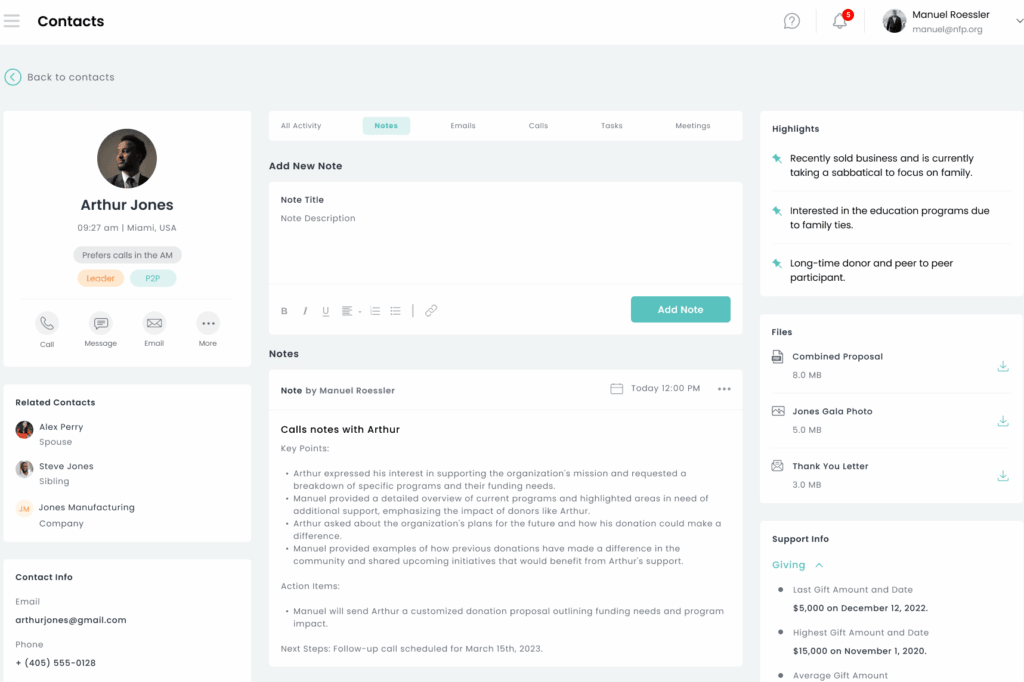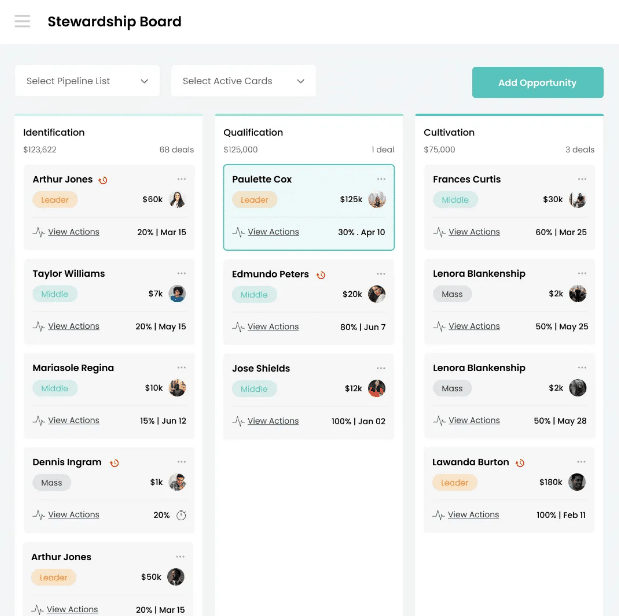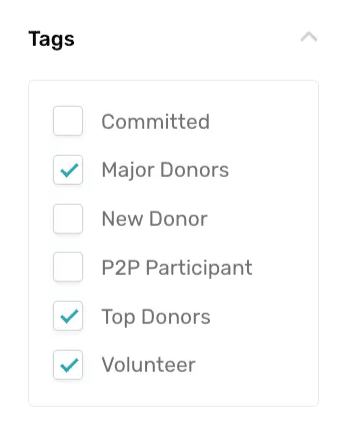If you’ve ever hoped a donor would magically become a major contributor after a single gala or email appeal, you’re not alone. It’s tempting to think a generous check will come out of nowhere, but in reality, major gifts rarely work that way.
The truth is, you don’t land major gifts by luck. These transformative contributions are almost always the result of a thoughtfully built relationship over time.
At the heart of major giving is trust, and trust isn’t built in a single transaction; it’s built in the in-between moments. I’m talking about the thoughtful check-ins, the relevant updates, and the genuine interest in a donor’s goals that make up intentionall donor stewardship. To do this well, especially at scale, you need a system.
Let’s walk through how you can use a system to cultivate major gifts through intentional donor stewardship.
The Stages of a Major Donor Pipeline
Major donors are cultivated, not born.
Think of it like a garden. You plant the seed by identifying someone with capacity and interest, then you nurture it. Some days that means sunshine and encouragement. Other days, it’s a gentle nudge or a thoughtful reminder. Eventually, that relationship blossoms into giving.
Here’s a breakdown of the stages in a major donor pipeline:
- Identification – Who has the potential to become a major donor? These might be long-time supporters, community leaders, or people newly connected to your mission. A “major donor” is commonly defined by a specific giving threshold (for example, $5,000 or more annually), but the exact amount varies by organization depending on its size, budget, and donor base.
- Qualification – Is this person a good fit for major giving? This stage involves research and early interactions to gauge capacity, interest, and alignment.
- Cultivation – The heart of donor relations. You’re getting to know the donor, sharing impact, and connecting over values and goals.
- Solicitation – With a strong relationship in place, you make a well-timed, thoughtful ask that aligns with their philanthropic vision.
- Stewardship – After the gift, you don’t stop the relationship. You deepen it. Thank them well. Show them their impact. Make them feel like a true partner.
Each stage requires intentional, customized touchpoints, and they require you to keep track of what’s been done, what’s next, and who on your team is responsible.
Examples of What Intentional Donor Stewardship Look Like
Donor stewardship doesn’t have to be complicated. It’s choosing quality over quantity and making sure each donor interaction feels personal and relevant.
Here are some real-life examples of intentional donor stewardship that lead to major gift readiness:
- Strategic Touchpoints – A phone call just to say thank you. A handwritten note acknowledging a donor’s first contribution. These small gestures build trust.
- Mission-Related Updates Based on Interests – If a donor is passionate about youth programs, send them a story about a student who benefitted from your latest initiative. It shows you’re listening.
- Exclusive Experiences – Invite major gift prospects to a behind-the-scenes tour, a conversation with your executive director, or a leadership briefing. Make them feel like insiders.
- Personal Check-Ins Without an Ask – Sometimes the best touchpoint is just saying, “I was thinking about you. How are you doing?”
- Impact Stories That Match Their Goals – If a donor supports education, share how their support helped increase graduation rates. Aligning their values with your outcomes makes giving feel like a shared win.
- Timely, Personalized Communication – Don’t just send updates quarterly. Respond to life events, holidays, and milestones. A birthday email or anniversary note shows you see them as a person, not just a donor.
- Ongoing Cultivation Beyond the First Gift – Stewardship isn’t just the thank you after the gift. It’s the continued relationship that can turn a one-time donation into a lifelong partnership.
Creating a Donor Stewardship System
Without a system, even the most well-intentioned stewardship strategies can fall apart.

Add notes and important information to major donor profiles with CauseVox’s CRM for nonprofits.
You might forget to follow up after a meeting. You might lose track of which team member last spoke with a donor. Notes might live in one person’s inbox and never get shared. And over time, these little breakdowns add up. They become missed opportunities, cold relationships, and an unpredictable pipeline.
Major gifts can’t be left to chance. Stewardship requires structure: a way to organize donor interactions, track progress, and prioritize outreach. This is where portfolio management comes into play, ensuring each donor has a clear path forward and that nothing falls through the cracks.
With a nonprofit CRM like CauseVox’s, you don’t have to rely on memory or messy spreadsheets. You can have a visual, easy-to-use system that shows exactly where each donor stands in your pipeline. From first interaction to final gift and beyond, every detail is logged, shared, and actionable.
That clarity allows your team to work together more effectively, focus on the right prospects at the right time, and ultimately, turn stewardship into consistent major gift success.
Using a Donor Stewardship Board
When managing a major donor portfolio, visibility is everything. You need to know where each prospect stands, who needs attention, and what’s coming next, without digging through spreadsheets and notes. That’s why a donor stewardship board is so powerful.
Kanban-Style Donor Stewardship Board
In CauseVox’s CRM, this takes the form of a Kanban-style board, a visual interface that helps you track and manage donor relationships through each stage of your pipeline, giving you a clear view of your entire donor journey at a glance.

Manage your donor stewardship pipeline, Kanban-style.
What makes this tool especially effective is its flexibility. You can customize your pipeline to fit the way your team works. Maybe you need a special stage for board review, or want to distinguish between first-time and recurring major donors. CauseVox lets you tailor the process to your strategy, not the other way around.
At-a-Glance Visibility
Each donor’s card shows their latest engagement, pinned notes, and next steps, so no one slips through the cracks. You can filter your view by things like stage, interest area, potential gift size, or last contact date, helping you quickly identify where to focus your energy this week. The system even alerts you to donors who are overdue for a touchpoint.
Collaborative Tracking
The board isn’t just for one person’s view. It supports collaborative tracking, which means tasks and donor contacts can be easily assigned to different team members. Everyone can access the same donor records, notes, and activity history in one centralized place. No more chasing down who made the last call or what was said in the last meeting.
With this level of organization, you’re keeping relationships warm while moving them forward with intention. You’re prioritizing your highest-potential prospects, ensuring timely follow-ups, and building a consistent donor experience that feels personal and seamless.
Benefits of Using a Tool Like This
Ultimately, a stewardship board like this does more than organize data. It increases team accountability, streamlines collaboration, and accelerates the major gift timeline. With a tool like CauseVox’s CRM, major donor stewardship becomes less of a guessing game and more of a guided process;and that’s how relationships thrive.
Use CauseVox’s CRM to Level Up Your Donor Stewardship
CauseVox’s CRM isn’t just another data management tool. It’s designed to help you build stronger relationships and deliver a donor experience that feels truly personal.
Everything about a donor is in one place, from giving history and engagement notes to key relationships and pinned insights. You can link contacts to their households or affiliated organizations, giving you a broader understanding of their connections and influence.
With segment tagging, you can group donors by interest or giving capacity and tailor your communications accordingly. Want to send a mission-specific update to donors who’ve supported a certain program? Or check in with lapsed major givers from last year? Tags and segmentation make it simple.

Deliver the right message to the right people at the right time using donor tags.
Activity tracking shows every touchpoint like calls, emails, texts, and meetings, along with milestones and engagement patterns. It helps you understand where the relationship is and what’s next. With custom fields, you can capture the unique details that matter most to your fundraising strategy.
Plus, it’s collaborative. Assign tasks, add notes, and loop in team members so that stewardship becomes a shared effort. Whether you’re a team of two or ten, you’ll stay aligned, efficient, and donor-focused.
Major Donors Are Grown, Not Given
Major donors don’t arrive ready to give big. They grow into that role through trust, authentic connection, and consistent engagement. When you treat donor stewardship as more than a follow-up step, you create space for deeper relationships and transformational giving.
With the right tools, this process becomes easier to manage and scale.Sign up for a free demo today to learn how you can use CauseVox’s CRM to manage your donor portfolio and build stronger relationships that lead to more major gifts.




